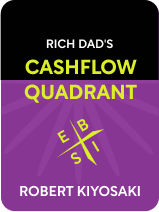

This article is an excerpt from the Shortform book guide to "Rich Dad's Cashflow Quadrant" by Robert T. Kiyosaki. Shortform has the world's best summaries and analyses of books you should be reading.
Like this article? Sign up for a free trial here .
Are you looking for Rich Dad’s Cashflow Quadrant quotes by Robert Kiyosaki? What are some of the most noteworthy passages worth revisiting?
In Rich Dad’s Cashflow Quadrant, Kiyosaki uses the concept of four “cashflow quadrants” to emphasize that it’s not what you do that makes the difference between achieving financial freedom and being stuck in a cycle of job dependency, but what kind of income you earn. He categorizes income generation strategies into four categories or quadrants: E (employee), S (self-employed and small-business owners), B (big business owners), and I (investors).
Below is a selection of Rich Dad’s Cashflow Quadrant quotes with explanations to help you put them into context.
Rich Dad’s Cashflow Quadrant: Guide to Financial Freedom
Robert Kiyosaki wants you to forget the traditional path from college to a good job to a stable retirement, because it doesn’t exist anymore. In Rich Dad’s Cashflow Quadrant, a sequel to Kiyosaki’s international bestseller Rich Dad, Poor Dad, he implores you to make your money the way the rich do: by developing assets. Using the simple concept of “Cashflow Quadrants,” Kiyosaki teaches you which types of income lead to financial freedom, and which don’t.
The following Rich Dad’s Cashflow Quadrant quotes by Robert Kiyosaki highlight some of his key teachings.
“You will never know true freedom until you achieve financial freedom.”
The ultimate purpose of wealth is to have the freedom to spend your time the way you want. But it isn’t the only type of freedom wealth brings. According to Kiyosaki, the ultimate goal of building wealth is a step further—financial freedom. The financially free can do nearly whatever they want, whenever they want because money is almost never an obstacle. According to Robert Kiyosaki, financial freedom should be your ultimate goal.
While Kiyosaki focuses on how to achieve 1-percenter, capitalist-level financial freedom, where all your time is yours and almost nothing is out of reach, he says the principles he puts forward are equally useful for reaching financial security. Even if you’re not willing to commit yourself to the risks and lifestyle it takes to achieve financial freedom, Kiyosaki thinks that, at minimum, you should strive for a life where concerns about money don’t dictate the way you live.
“Remember that anything important can’t really be learned in the classroom. It must be learned by taking action, making mistakes, and then correcting them. That’s when wisdom sets in.”
Many people who excel in business, and many other fields, were poor students in their traditional education. According to Kiyosaki, school creates an environment where students are afraid to fail and failure is punished. “A” students never failed in school, and so they become adults who are afraid to experience failure. “C” students already got over the shock of not being the best every time. For that reason, they’re more willing to take risks, which is key to success in the B and I categories.
Many skills important in business and money-making (and life in general) aren’t taught in school and are often more important than an A in advanced English or trigonometry. Kiyosaki emphasizes that we need to learn to love learning, but that some of the most important learning happens outside of traditional education. It’s vital to figure out what you want to learn about, and how you want to learn about it. It may look nothing like sitting in a classroom.
“More money will not solve the problem if cash-flow management is the problem.”
Cashflow is the total amount of money you earn and spend, and is the total of your income, expenses, liabilities, and assets. According to Robert Kiyosaki, cashflow is the central difference between generating income in the E (employee) and S (small business owner) quadrants and the B (big business owner) and I (investing) quadrants.
In the E and S categories, cashflow looks like this:
- Salary/Small Business Profit – Expenses = Income
For an example in the E category, a teacher’s salary minus her living expenses equals her income. In the S category, a writer’s freelancing income minus her living expenses equals her income.
If you have liabilities in the E and S categories, your cashflow looks like this:
- Salary and/or Business Profit – Expenses and Liabilities = Income
With liabilities, a teacher or freelancer’s salary minus her living expenses minus her student loans and mortgage debt equals her income.
In the B and I categories, cashflow looks like this:
1. Capital → Assets
First, when you invest, you make an informed bet that your investment will be profitable. A profitable investment is an asset and will supply you with passive income.
2. Passive Income from Assets – Expenses & Liabilities = Income
Once you have passive income, that, minus your expenses and your liabilities if you have them, is your income. This is a fundamentally different way of making money.
“Warren Buffett is saying that portfolio concentration, or focusing on a few investments rather than diversifying, is a better strategy.”
Kiyosaki says that wealthy people don’t diversify their assets, and you shouldn’t either. He says it’s better to choose one, or just a few, investment categories so you can become deeply knowledgeable about them and make smarter investments.

———End of Preview———
Like what you just read? Read the rest of the world's best book summary and analysis of Robert T. Kiyosaki's "Rich Dad's Cashflow Quadrant" at Shortform .
Here's what you'll find in our full Rich Dad's Cashflow Quadrant summary :
- Why the traditional path of college to career doesn't work
- Which types of income will lead you to financial freedom
- An in-depth look at Robert Kiyosaki's four cashflow quadrants






